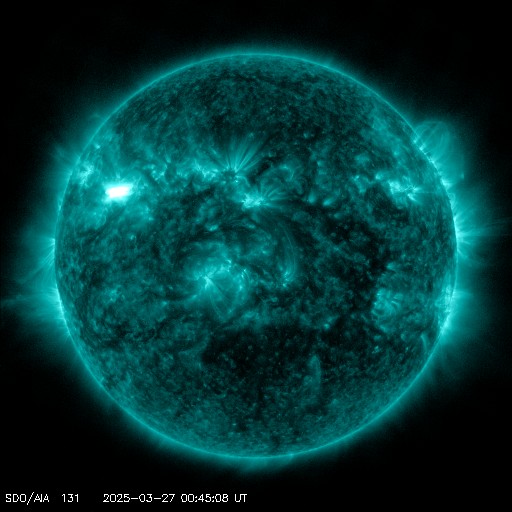Viewing archive of Friday, 22 March 2002
Solar activity report
Any mentioned solar flare in this report has a scaling factor applied by the Space Weather Prediction Center (SWPC). Because of the SWPC scaling factor, solar flares are reported as 42% smaller than for the science quality data. The scaling factor has been removed from our archived solar flare data to reflect the true physical units.
Report of Solar-Geophysical Activity 2002 Mar 22 2200 UTCPrepared by the NOAA © SWPC and processed by SpaceWeatherLive.com
Joint USAF/NOAA Report of Solar and Geophysical Activity
SDF Number 081 Issued at 2200Z on 22 Mar 2002IA. Analysis of Solar Active Regions and Activity from 21-2100Z to 22-2100Z
Solar activity increased to moderate levels. Region
9866 (S10W96) produced a long-duration M1 X-ray flare at 22/1114 UTC
as it crossed the west limb. The flare was associated with a halo
CME and a proton event at greater than 10 MeV. Region 9866 was in a
slow decay phase during the last few days of its passage. Region
9878 (N08E54) produced a C8 X-ray flare at 22/0618 UTC. Minor growth
may have occurred in this region. Region 9871 (S20W47) retained
minor magnetic complexity near its leader spots, but was relatively
stable. New Regions 9881 (S05W08) and 9882 (N15E74) were numbered.
IB. Solar Activity Forecast
Solar activity is expected to be low
to moderate. There is a fair chance for an isolated, low-level
M-class flare during the period.
IIA. Geophysical Activity Summary 21-2100Z to 22-2100Z
Geomagnetic field activity was at quiet to unsettled levels. A
greater than 10 MeV proton event began at geo-synchronous orbit at
22/2020 UTC in the wake of today's long-duration M1 flare. The event
was in progress and slowly increasing at the close of the period
with a reading of 10.5 pfu at 22/2100 UTC.
IIB. Geophysical Activity Forecast
Geomagnetic field activity is
expected to be at quiet to unsettled levels during most of the
period. However, there will be a chance for brief active levels on
25 March in response to today's CME. The greater than 10 MeV proton
event is expected to end early on 23 March.
III. Event Probabilities 23 Mar to 25 Mar
| Class M | 40% | 40% | 40% |
| Class X | 05% | 05% | 05% |
| Proton | 99% | 01% | 01% |
| PCAF | green | ||
IV. Penticton 10.7 cm Flux
Observed 22 Mar 172 Predicted 23 Mar-25 Mar 170/165/165 90 Day Mean 22 Mar 212
V. Geomagnetic A Indices
Observed Afr/Ap 21 Mar 005/008 Estimated Afr/Ap 22 Mar 008/008 Predicted Afr/Ap 23 Mar-25 Mar 010/010-010/012-010/015
VI. Geomagnetic Activity Probabilities 23 Mar to 25 Mar
| A. Middle Latitudes | |||
|---|---|---|---|
| Active | 25% | 25% | 25% |
| Minor storm | 10% | 10% | 10% |
| Major-severe storm | 05% | 05% | 05% |
| B. High Latitudes | |||
|---|---|---|---|
| Active | 30% | 30% | 30% |
| Minor storm | 15% | 15% | 15% |
| Major-severe storm | 05% | 05% | 05% |
All times in UTC
Current data suggests there is a slight possibility for aurora to appear at the following high latitude regions in the near future
NuukLatest news
Latest forum messages
AR4043 11Large Coronal Hole 25 137Aurora photography hints for those of us with smartphones 43Photographing auroras 34More on an art than a science 3
More topicsSupport SpaceWeatherLive.com!
A lot of people come to SpaceWeatherLive to follow the Sun's activity or if there is aurora to be seen, but with more traffic comes higher server costs. Consider a donation if you enjoy SpaceWeatherLive so we can keep the website online!

Latest alerts
00:57 UTC - Solar flare
Moderate M2.05 flare
00:33 UTC - Radio Blackout
Minor R1 radio blackout in progress (≥M1 - current: M1.71)
Wednesday, 26 March 2025
23:00 UTC - Geomagnetic activity
Minor G1 geomagnetic storm (Kp5) Threshold Reached: 22:37 UTC
20:30 UTC - Geomagnetic activity
Moderate G2 geomagnetic storm (Kp6) Threshold Reached: 20:08 UTC
20:15 UTC - Geomagnetic activity
Minor G1 geomagnetic storm (Kp5) Threshold Reached: 20:00 UTC
Space weather facts
| Last X-flare | 2025/02/23 | X2.0 |
| Last M-flare | 2025/03/26 | M1.0 |
| Last geomagnetic storm | 2025/03/22 | Kp6- (G2) |
| Spotless days | |
|---|---|
| Last spotless day | 2022/06/08 |
| Monthly mean Sunspot Number | |
|---|---|
| February 2025 | 154.6 +17.6 |
| March 2025 | 135 -19.6 |
| Last 30 days | 133.8 -19.2 |






